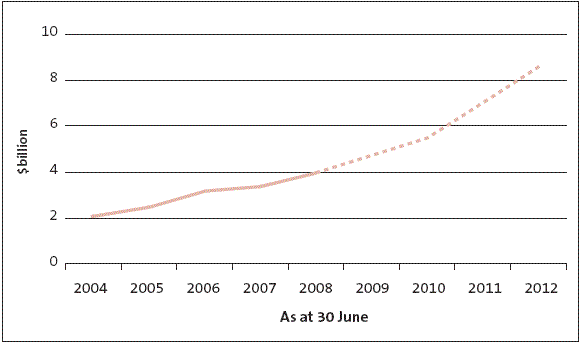Part 1: Introduction
1.1
For most New Zealanders, paying tax is a part of life. In 2007/08, there were about 6.5 million taxpayers (individuals, companies, trusts, and other entities), who paid the Inland Revenue Department (Inland Revenue) a total of $51.2 billion.
1.2
The tax system is based largely on voluntary compliance, and most taxpayers (86% in 2007) pay their taxes on time. However, some taxpayers do not meet their tax obligations. As at 30 June 2008, there were 202,000 cases of outstanding tax debt,1 totalling $4.036 billion. Of this, $2.216 billion was considered to be collectable debt2 and $1.820 billion was considered to be non-collectable debt.3
1.3
In the context of this report, "tax debt" refers to amounts owing for income tax in its various forms (mainly that payable by individuals and companies) and goods and services tax.
1.4
About $1.606 billion (40%) of the total tax debt (as at 30 June 2008) is made up of penalties and interest. Legislation requires Inland Revenue to charge interest on a taxpayer's outstanding debt, but under certain circumstances Inland Revenue can remit interest and penalties. These circumstances include serious hardship, if the maximum amount of debt has been recovered, or it is inefficient for Inland Revenue to continue chasing the debt.
1.5
Between 2004 and 2008, the total tax base grew by 35%, but total tax debt increased by 91% ($1.92 billion). This indicates that Inland Revenue's collection practices are not keeping pace with tax debt. For the 2007/08 year, Inland Revenue had 428 staff doing tax debt work (and similar numbers for the two years before that).
1.6
Inland Revenue acknowledges that the growth in tax debt is outpacing its capacity for dealing with the debt, and is putting pressure on organisational resources. Inland Revenue has told us that it believes society's attitude towards debt has led to a growth of both household debt and personal debt in New Zealand. It believes that this has also contributed to the growth in tax debt. Inland Revenue told us that its active targeting of large-value non-compliant taxpayers for auditing has also contributed to the rising debt trend by identifying more tax due.
1.7
Inland Revenue has predicted that tax debt could more than double within five years, unless it "takes a fresh approach" to managing debt (see Figure 1).
Figure 1
Actual and projected increases in tax debt, 2004-2012

Source: Inland Revenue
Why and how we carried out our audit
1.8
Because the amount of outstanding tax debt is significant and growing, we carried out a performance audit to provide assurance to Parliament that Inland Revenue was effectively and efficiently managing tax debt. Our audit examined whether Inland Revenue is:
- taking a strategic approach to tax debt management (Part 2);
- effectively identifying and recovering debt through its automated actions and debt officers (Part 3); and
- adequately monitoring and reporting its performance (Part 4).
1.9
We expected Inland Revenue, in taking a strategic approach, to:
- have strategies to manage the effects of the growth in tax debt (to the extent that these are within Inland Revenue's influence); and
- manage tax debt cases consistently throughout the country.
1.10
We expected Inland Revenue, in effectively identifying and recovering tax debt, to:
- have processes to ensure that older tax debt cases are actively managed so that the debt is recovered; and
- have debt staff who are well trained and well supported in their decision-making.
1.11
In terms of adequately monitoring and reporting its performance, we expected Inland Revenue to:
- analyse the success of each of its methods used to recover tax debt and enforce compliance;
- regularly monitor and report trends in tax debt; and
- have all information required for monitoring and reporting readily available.
How we carried out our audit
1.12
We requested and reviewed a wide range of documents and reports, both public and internal. We watched demonstrations of computer systems, and reviewed 40 randomly selected tax debt cases from a range of taxpayers. We interviewed 30 Inland Revenue staff in four different cities. We also met with relevant external organisations to get their views on how Inland Revenue is managing tax debt.
Outside the scope of our audit
1.13
We did not assess:
- the efficiency of debt information systems;
- the accuracy of data in the debt information systems; or
- Inland Revenue's management of debt that was not tax debt.4
1: "Outstanding tax debt" is tax debt that has not been paid by its due date.
2: "Collectable debt" is tax debt that Inland Revenue reasonably expects to collect. It includes debt being repaid in instalments, and cases where collection action is pending.
3: "Non-collectable debt" is tax debt that cannot currently be collected. It includes Inland Revenue's assessment of debt when a taxpayer fails to file a return (default assessments), and debt owing that is under investigation or dispute (deferred debt). It also includes debt owing that is subject to bankruptcy, liquidation, or receivership action, and debt to be written off. Some non-collectable debt can become collectable after disputes or returns are finalised.
4: The non-tax debt comprises Child Support debt, Working for Families Tax Credit debt, and overdue student loan repayments.
page top
